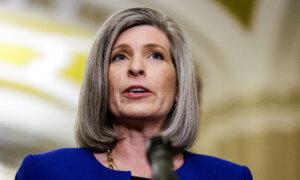‘Trump has enormous power in the budget,’ economist and fiscal expert Chris Edwards says.
As entrepreneurs Elon Musk and Vivek Ramaswamy trek to Washington to meet with GOP lawmakers this week, they have an even longer road ahead of them to achieve their goals of enacting major cuts to government budgets.
The incoming Trump administration has set itself an ambitious goal through the newly created Department of Government Efficiency (DOGE), which will be headed by Musk and Ramaswamy, of slashing federal budgets and even eliminating an agency or two.
There has been an enthusiastic response.
“I’ve been blown away by the talent of individuals that have reached out,” Anson Frericks, a longtime friend and co-founder of Strive Asset Management with Ramaswamy, told The Epoch Times. Frericks said that many people have contacted him in an effort to connect with Ramaswamy.
“It’s been people that have been former CEOs, former entrepreneurs, that have exited their companies and that don’t need the money, but they’re very committed to the idea of a smaller government, and they would be part of the group,” Frericks said.
Congressional Support and Limitations
GOP lawmakers appear to be receiving this less-is-more message positively.
But the DOGE team, for all its enthusiasm, has many hurdles in its way.
Focus on Federal Subsidies
Chris Edwards, former senior economist on the Congressional Joint Economic Committee and currently a Cato Institute fellow and editor of DownsizingGovernment.org, has proposed a top 10 list for the Trump administration to consider and suggests that more than $1 trillion could be cut from federal aid programs.
“There’s over 1,300 federal aid-to-state programs currently for education and public housing and highways,” he told The Epoch Times. “But with all those spending programs and aid to the states comes all these complicated regulations.”
Even though the Constitution gives the federal government no authority over areas including education, health care, and housing, federal grants have often come with strings attached as a way for Washington to expand its control over states.
The first sector to cut is federal subsidies for K–12 schools, Edwards said, which could save more than $30 billion a year.
“I think there’s an understanding in the Republican Party now that we really ought to get the feds out of K–12 schools, and Trump himself has said that,” Edwards said.
“Canada has no federal department of education; they do not have federal subsidies for K–12 schools, and it is entirely locally funded and controlled. Canadian kids consistently do better on international tests than we do.”
Whereas federal education programs, like the Every Student Succeeds Act and No Child Left Behind, tend to centralize and nationalize school curriculums, Trump will take office when an increasing number of states are moving in the opposite direction, toward school choice programs that give parents more choices for their children’s education.
Other spending programs that Trump could cut, Edwards said, include urban transit subsidies ($20 billion), unspent subsidies and tax breaks in the Inflation Reduction Act (IRA) for wind and solar energy, subsidies for batteries and electric vehicles ($100 billion), broadband subsidies in the 2021 Infrastructure Bill ($65 billion), housing and community development grants ($75 billion), and farm subsidies—60 percent of which goes to the country’s largest farms.
Spending Programs Are Popular
One problem that the incoming administration will face, however, is that many of these programs are popular, and Trump will start his second term with a thin GOP majority in Congress. As of Nov. 29, Republicans are projected to have only a 2-seat majority in the House of Representatives, with three races still uncalled.
But that doesn’t necessarily mean that Congress, or voters, will oppose budget cuts.
Focus on Waste, Real Estate, Defense, Federal Workers
There are also numerous cases of waste that could be eliminated. Among them were $236 billion in improper payments in 2023, according to a Government Accountability Office report, and $1.3 billion paid to deceased people last year, cited in a report from RealClear Investigations, based on data from the Office of Management and Budget.
In addition, Edwards said, there are potential savings in selling off some of the approximately 300,000 buildings owned by the federal government.
“They’ve got all this excess real estate,” he said. “They should consolidate the real estate and save a lot of money that way.”
“I think you can be much more efficient using drones, using AI, using less costly technology that doesn’t put humans at risk, so I think those are other opportunities to shrink the amount of money the government spends while still producing better outcomes,” Frericks said.
Reducing head count among civil servants is another area of focus, and advocates have said they can achieve some of this by relocating departments outside of Washington and requiring federal workers to work from their respective offices rather than from home.
A History of Failure
History cautions against hubris, however, when taking on the approximately 460 agencies of the federal government. This is not the first time that outsiders have attempted to prune the administrative state, and prior attempts have not succeeded.
In June 1982, President Ronald Reagan established the President’s Private Sector Survey on Cost Control in the Federal Government (PPSSCC), commonly known as the Grace Commission after its Chairman J. Peter Grace, CEO of W. R. Grace & Company. This commission included about 150 prominent business executives tasked with reviewing the entire executive branch and recommending how to cut waste and inefficiency.
Eighteen months later, the Grace Commission produced a list of approximately 2,500 recommendations on how to cut federal spending. According to the Reagan Presidential Library, however, “most of the recommendations, especially those requiring legislation from Congress, were never implemented.”
Ultimately, it was President Bill Clinton’s administration that brought federal budgets back into balance in 1998.
In 2010, President Barack Obama’s administration established the bipartisan National Commission on Fiscal Responsibility and Reform, also called Simpson-Bowles after co-chairs Alan Simpson and Erskine Bowles. Ultimately, this commission proposed $2.9 trillion in spending cuts, coupled with an approximately equal amount of tax increases. But its proposals failed to gain enough support in Congress (or even within the commission), though some of its recommended spending cuts were later put in place.
Another potential impediment is timing; the recommendations from DOGE are expected to be delivered in the summer of 2026, by which time Trump would be well into his second and final term in office. By then, the GOP may have lost some of its momentum from November’s electoral victories, and potentially its congressional majorities in the 2026 midterms.
But this doesn’t mean that Trump cannot succeed, given sufficient will and focus.
“Trump has enormous power in the budget,” Edwards said. “People say Congress is the one who spends, but Constitutionally it’s both, because Trump has veto power.
“He can put some of the top recommended cuts from Elon and Vivek into the budget and simply refuse to sign the budget until he gets some substantial cuts.”
Original News Source Link – Epoch Times
Running For Office? Conservative Campaign Consulting – Election Day Strategies!


